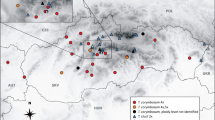Abstract
Due to the variability in morphology and color of the flowers as well as the excellent post-harvest durability of Alstroemeria, many species are cultivated as ornamental and cut flowers. Alstroemeria ligtu L., endemic to Chile, has also been a source of artificial hybridizations for development of new cultivars. Cytogenetic studies provide clues for possible breeding programs and taxonomically useful data to clear up infraspecific relationships of Chilean native populations. Three subspecies are recognized within A. ligtu: subsp. ligtu, subsp. splendens Muñoz-Schick, and subsp. simsii (Sprengel) Bayer. The objective of this paper is to characterize karyotypically these subspecies and to clarify their taxonomic status. Fourteen populations were collected throughout its distributional range. Chromosome number, karyotypic formulae, karyotypes, ideograms, intrachromosomal asymmetry index MCA, and interchromosomal asymmetry index CVCL were calculated. All studied populations showed 2n = 2x = 16 chromosomes. Subspecies ligtu and simsii are clearly differentiated from each other in MCA and together from subsp. splendens with CVCL. Intrachromosomal asymmetry index revealed two populational groups within subsp. splendens. These populations also differ in karyotypes formulae, habitat, soil type, and distribution. We concluded that a fourth subspecies should be described from populations located in the lower part of the cordillera de los Andes in the Region of Maule. Populations of higher elevations correspond to those already described as subsp. splendens.






Similar content being viewed by others
References
Aagesen L, Sanso M (2003) The phylogeny of the Alstroemeriaceae, based on morphology, rps16 Intron, and rbcL sequence data. Syst Bot 28:47–69
Aker S, Healy W (1990) The phytogeography of the genus Alstroemeria. Herbertia 462:76–87
Baeza C, Ruiz E (2011) Alstroemeria hookeri Lodd. subsp. sansebastiana C.M. Baeza & E. Ruiz, nueva para la flora de Chile. Gayana Bot 68:313–315
Baeza M, Schrader O, Ruiz E, Negritto M (2006) Análisis comparativo del cariotipo en poblaciones de Alstroemeria ligtu subsp. ligtu y A. ligtu subsp. simsii (Alstroemeriaceae) de Chile. Darwiniana 44:313–318
Baeza C, Schrader O, Budahn H (2007) Characterization of geographically isolated accessions in five Alstroemeria L. species (Chile) using FISH of tandemly repeated DNA sequences and RAPD analysis. Plant Sys Evol 269:1–14
Baeza M, Schrader O, Ruiz E, Negritto M (2008) Alstroemeria presliana Herb. (Alstroemeriaceae) in Chile from a cytogenetic perspective. Chil J Agric Res 68:328–333
Baeza C, Ruiz E, Negritto M (2010) Comparative karyotypic analysis in the Alstroemeria hookeri Lodd. (Alstroemeriaceae) complex sensu Bayer (1987). Gen Mol Biol 33:119–124
Baeza C, Finot V, Ruiz E (2015) Comparative karyotype analysis of populations in the Alstroemeria presliana Herbert (Alstroemeriaceae) complex in Chile. Gen Mol Biol 38:199–204
Bayer E (1987) Die Gattung Alstroemeria in Chile. Mitt Bot Staatssaml München 24:1–362
Buitendijk J, Ramanna M (1996) Giemsa C-banded karyotypes of eight species of Alstroemeria L. and some of their hybrids. Ann Bot 78:449–457
Buitendijk J, Peters A, Jan-Quené R, Ramanna M (1998) Genome size variation and C-band polymorphism in Alstroemeria aurea, A. ligtu and A. magnifica (Alstroemeriaceae). Plant Syst Evol 212:87–106
Cajas D, Baeza C, Ruiz E, Negritto M (2009) Cytogenetic analysis in populations of Alstroemeria hookeri Lodd. subsp. hookeri (Alstroemeriaceae) from Bio-Bío Region, Chile. Gayana Bot 66:117–126
De Jeu M, Jacobsen E (1995) Early postfertilization ovule culture in Alstroemeria L. and barriers to interspecific hybridization. Euphytica 86:15–23
Finot VL, Baeza CM, Melín P, Novoa P, Campos J, Ruiz E, Fuentes G, Albornoz P, Carrasco P (2015) ¿Es Alstroemeria pulchra Sims var. maxima Phil. (Alstroemeriaceae) un miembro del complejo A. magnifica Herbert?: estudio colorimétrico de los tépalos externos e internos de la flor. Gayana Bot 72:101–113
González AV, Murúa M, Perez F (2014) Floral integration and pollinator diversity in the generalized plant-pollinator system of Alstroemeria ligtu (Alstroemeriaceae). Evol Ecol 29:63–75
Hutchinson M, Senaratna T, Tsujita J, Saxena P (1997) Somatic embryogenesis in liquid cultures of a tetraploid Alstroemeria. Pl Cell Tissue Org Cult 47:293–297
Levan A, Fredga K, Sandberg A (1964) Nomenclature for centromeric position on chromosomes. Hereditas 52:201–220
Miyake I, Mobara S, Chiba K (1989) Breeding spotless Alstroemeria in Japan. Herbertia 45:40–44
Muñoz M, Moreira A (2003) Alstroemerias de Chile. Diversidad, distribución y conservación. Taller La Era, Santiago
Negritto M, Baeza C, Ruiz E, Novoa P (2015) Alstroemeria marticorenae (Alstroemeriaceae), a new species from central Chile. Syst Bot 40:69–74
Peruzzi L, Eroglu H (2013) Karyotype asymmetry: again, how to measure and what to measure? Comp Cytogenetics 7:1–9
Ravenna P (1988) New or noteworthy species of Alstroemeria. Phytologia 64:281–288
Reeves A (2001) MicroMeasure: a new computer program for the collection and analysis of cytogenetic data. Genome 44:239–443
Zhou S, De Jeu M, Visser R, Kuipers A (2003) Characterization of distant Alstroemeria hybrids: applications of highly repetitive DNA sequences from A. ligtu ssp. ligtu. Ann Appl Biol 142:277–283
Acknowledgments
This work was supported by Fondecyt grant Nº 1130349. We thank Gabriele Kottirsch and Janina Baeza for technical assistance in field. We are grateful to the Minera Río Teno-Biobío Cementos S.A. for the authorization to collect material of Alstroemeria ligtu subsp. splendens.
Author information
Authors and Affiliations
Corresponding author
Rights and permissions
About this article
Cite this article
Baeza, C., Finot, V., Ruiz, E. et al. Comparative karyotypic analysis and cytotaxonomy in the Alstroemeria ligtu L. (Alstroemeriaceae) complex of Chile. Braz. J. Bot 39, 305–313 (2016). https://doi.org/10.1007/s40415-015-0220-4
Received:
Accepted:
Published:
Issue Date:
DOI: https://doi.org/10.1007/s40415-015-0220-4




